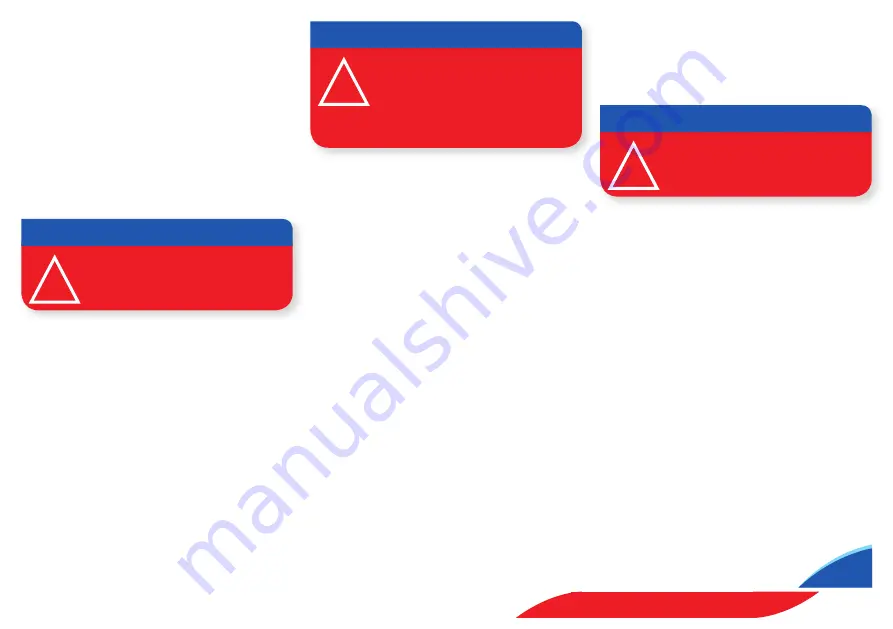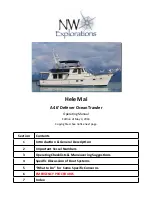
p. 15
Owners Manual
• Use a soft, grit-free cloth or soft, clean sponge.
• Never use glass cleaning solutions or dusters,
as they will scratch the surface.
• Do not use solvents such as acetone,
kerosene, benzine, carbon tetrachloride, fire
extinguisher fluid, dry cleaning fluid, lacquer
thinner or any type of cleaning product
containing these items, since they will attack
the surface.
• When finished, rinse with fresh water and dry
with a clean, damp chamois using a blotting
action.
STAINLESS STEEL
Stainless steel fittings should be cleaned with
neutral soap and water. Because irreversible pitting
will develop under rust that remains on stainless
steel for any period of time, it is best to remove rust
spots immediately with a chrome cleaner. Then
coat the railing or fitting with a good car or boat
wax. Never clean with mineral acids or bleaches.
Also, do not allow stainless steel to come into
continuous contact with iron, steel or other metals
which could cause contamination leading to rust
or corrosion.
SEATS
Please ensure you regularly remove all seats from
floor positions and clean thoroughly. Seats may
seize or bind if permanently left in place.
FABRICS
Prior to cleaning any fabric, we suggest testing the
cleaning solution on an inconspicuous area.
Vinyl tops and upholstery can be cleaned using
a neutral soap and water solution. Vinyl cleaners
and conditioners are not recommended for use
on upholstery. To prevent rainwater seepage at the
seams, a coating of Scotch Guard can be applied
on the inside of the vinyl top.
Mildew can occur if the boat does not have
adequate ventilation. Heat alone will not prevent
mildew. If mildew does occur, it can often be
removed using a solution of hot water and laundry
bleach (as per manufacturer’s instructions). Brush
the solution into the affected area, leave for 10 to
15 minutes and rinse with plenty of fresh water. If
possible, the vinyl top parts of your boat should be
stored indoors in a fairly warm, dry place. This will
greatly extend the life of the material. Dry cleaning
should be considered for interior fabrics other than
vinyl.
INSTRUMENTS AND GAUGES
When instruments are exposed to a saltwater
environment, salt crystals may form on the bezel
and plastic covers. These salt crystals should
be removed with a soft, damp cloth; never use
abrasives or rough, dirty cloths to wipe plastic
parts. Neutral household detergents or plastic
cleaners can be used to keep the instruments
bright and clean.
HULL, PAINT SERVICE AND WARRANTY.
To maintain the appearance and value of your boat,
it is necessary to perform regular maintenance
using the proper procedures. Always maintain
your boat in compliance with any pertinent
environmental pollution control regulations.
Carefully select the products to be used for
washing etc., to be sure they do not contain
corrosives. If in doubt contact your authorised
dealer for assistance.
OXIDISATION
Aluminium reacts naturally with the environment
and produces a protective coating called oxide.
This process is called oxidisation. Salt and moisture
are very common causes of oxidisation in boats
and is a normal reaction.
In a painted boat, this reaction can cause the paint
to bubble and flake off in areas throughout the
boat where the paint seal has been broken and
allowed moisture to enter. This is only a
cosmetic reaction and will not affect
the boat structurally.
The seats or lounges are not to be stood on,
or used as steps to enter or exit the boat.
This practice could cause injuries to the
boat occupants and also damage the seat
and or fabric.
ATTENTION
!
Do not place vessels in salt or chlorinated
pools.
ATTENTION
!
When washing the windscreen use only
fresh water.
ATTENTION
!










































